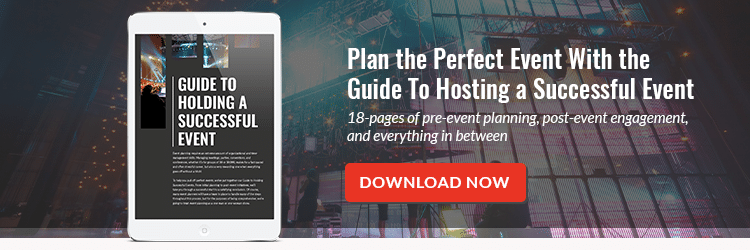Holding a conference event can be a tricky undertaking because the truth is, many people simply don’t like them! This can make it especially difficult for planners. According to Conventionnation, some of the main reasons people dislike conferences, conventions, and other corporate events is because they’re inconvenient, often disorganized, and cover too much material, resulting in the dreaded “information overload.” So how do you engage people that would rather be anywhere but at your event?
6 Ways to Engage Your Audience at a Conference Event
Create Table Teams
At large conference events, attendees may not know the people they’re sitting with very well—or even at all. Get them to open up by turning tables into teams, and allow 30 minutes or so at the start of the event for each table to create a unique team name and logo. Once teams have been created, it’s important to develop some projects or problem-solving scenarios during the event that will pit teams against one another, building camaraderie among attendees at each table.
Do Crowd Polling
It’s human nature to want to know how our thoughts compare to those of our colleagues—that’s why online polls are so popular! Take that same concept and integrate it into your convention or event. There are a variety on polling apps, devices, and plugins that can be used to conduct live polls during presentations. With most, answers remain anonymous, encouraging more participation—and honesty—from attendees.
Hold Panel Discussions
No matter how dynamic a speaker may be, it can grow tiresome seeing the same person on stage for hours (it’s also tough on the speaker). Instead, corporate event planning should integrate panel groups into the presentation, in which a number of subject matter experts take the stage at once and are offered a short time to provide their viewpoint; often, this results in some good back-and-forth interaction between speakers, making the presentation much more insightful and engaging for attendees and the panel participants.
Provide Superior Technology
Today’s tech-savvy conference event attendees aren’t going to take too kindly to the low-tech whiteboards and flip charts of yesteryear (they’re going to have little tolerance for poor audio too; how are they supposed to learn if they can’t hear what’s being communicated?) So, event planners need to up their A/V game, providing superior audio and quality visuals, from HD TVs to larger projection systems. Lighting should also be a consideration; the right lighting can create a unique atmosphere that keeps attendees engaged while highlighting speakers. Want to take it a step further? Incorporate an eye-popping LED video wall into the event to make a big, bright, and bold statement, and then ditch the traditional red drape and opt for a great stage backdrop to tie it all together.
Hold After Hours Events
If your conference event or convention is of the two- or three-day variety, many attendees will retreat to their hotel rooms once the day’s event is done. Keep them engaged and getting to know one another by hosting offsite events following the function, such as happy hours, sightseeing tours, sporting events, or even a trip to the indoor driving range (yes, they even have these in New York). This can create lasting relationships that make the event more than just something that “has to be done.”
Make Networking More Engaging
Research reveals that 75% of people attend conferences to make new connections. However, networking breaks are often unstructured, and many attendees wind up talking only to people they already know. So, get them out of their comfort zone with some simple ice-breaker activities.
- With smaller groups, play a game; you might have attendees engage in a round of “two truths and one lie.” People will discover others who they have something in common with, which will give them a reason to engage in further conversation later.
- Make networking a competition! Inform attendees that there will be a prize for collecting the most business cards (make the prize worthwhile). This gives them more incentive to speak with fellow attendees, and a reason to approach them in the first place.
- Consider “speed networking.” Attendees face each other across a table, and are given 1-2 minutes to chat before a buzzer signals that time is up and they must move to the next attendee in line. Then, once mingling commences, they know which people they want to approach for further discussion.
The event planning process requires a lot of thought, but it shouldn’t be a chore; when you consider the techniques and technology available to you, it can actually be a lot of fun! If you’re planning a conference event or convention of your own and want to up your A/V game, contact the professionals at One Way Event Productions rental company and hold a conference event that will leave attendees in awe.


